Tonight the Novel Hall launches its annual Novel Dance Series and as expected, artistic director Lin Hwai-min (林懷民) has chosen an outstanding line-up that will leave Taipei audiences with a lot to talk about for quite a while.
The theme of this year's series is "Men Dancing," the second time that the focus has been on male dancers since the series began in 2000. Making a return to the Novel stage will be Japan's Saburo Teshigawara, Britain's Akram Khan and Thailand's Pichet Klunchun, while another familiar face, abeit from a different setting, will be former Cloud Gate Dance Theater member Cheng Tsung-lung (鄭宗龍).
While the other performers — Jyrki Karttunen, Sang Jijia and Sidi Larbi Cherkaoui — may be less well known to Taipei audiences, they are becoming familiar names in their own countries and on the world's stages.
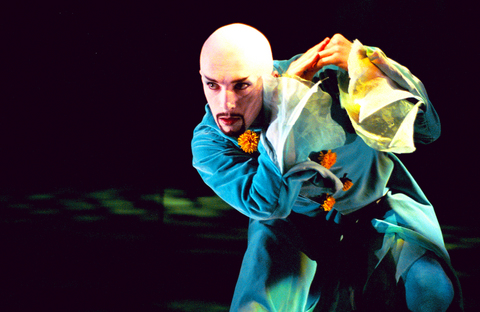
PHOTOS: COURTESY OF NOVEL HALL
When I asked Elaine Huang (黃麗宇), Novel Hall's public relations manager, why they were doing a second series on men, she said she didn't know, and Lin had not explained why. Akram and Saburo, however, were key to Novel's dance series, she said, and Lin wanted to keep them in front of Taipei audiences.
"For the others, like the "Fairy" from Finland, and the three Asians [next weekend], represent the younger generation of choreographers … so it's easy to collect all the male choreographers into a series," Huang said.
"Hot, new and fresh," were the key words to describe these artists, she said.
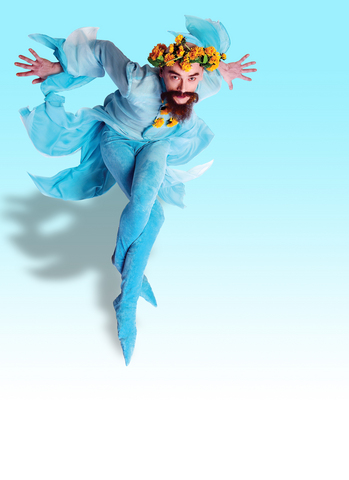
Karttunen, who will be performing this weekend, began his dance career with the Helsinki City Theatre Dance Company, where he danced from 1989 to 1993 and is a founding member of the Finnish artistic cooperative Nomadi Productions. He began choreographing in 1995, although he says he didn't really feel like he had become a choreographer until 1998, when he created digital duende.
In his 12 years as a choreographer, Karttunen has become known for his humor and for the ability to mix light-heartedness with darker reflection, both of which will be on display in his 2002 work Keiju (fairy in Finnish).
Keiju tells the story of a turquoise-clad, marigold-crowned fairy who must search for his ideal world after being catapulted into a timeless dimension between the world of flowers and everyday life — and losing the ability to fly. Thanks to the magic created by multi-media projections onto four proscenium-to-floor length screens, the audience will see Karttunen dancing with himself or multiple images of himself (each of which is clad in a slightly different color scheme, with differing flower headdresses to boot).
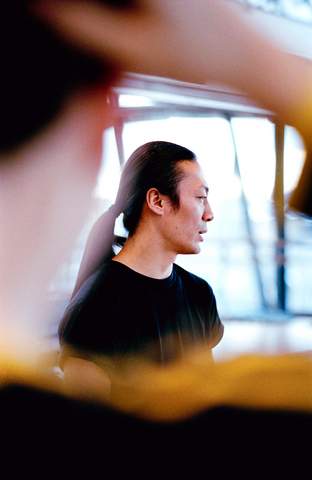
"The idea was to go into the color spectrum when lined up — from turquoise to lime green — to show different aspects of myself and how I was so lonely that I had to keep myself company," he said at a press conference yesterday.
However, since folktales don't explain about the sex of fairies or how they reproduce, his costume and make-up had to be a mix of male and female, he said.
While Keiju sounds like it might be a folktale for children, Karttunen was actually grappling with very adult themes when he created the work in the fall of 2001.
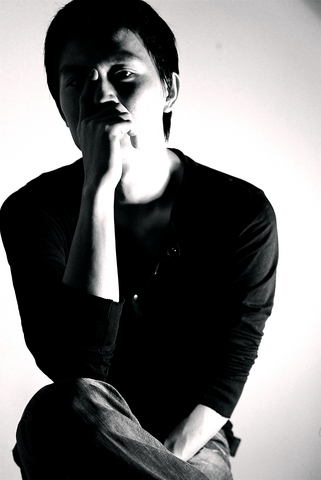
"There was a big feeling of loss in autumn 2001 after 9/11 ... [The question was] could I do something to comfort people?" he said. " I wanted to do a fairy tale for adults — but also questioning whether a piece could only be about happiness or the quest for it."
For the fairy, the quest is to learn to fly again. For Karttunen the creation of Keiju was also a quest over the four-month production period.
"My vision of the world today is very chaotic ... we are losing the ability to be alone, quiet, silent," he said. "I learned to be quiet, silent — without getting depressed."
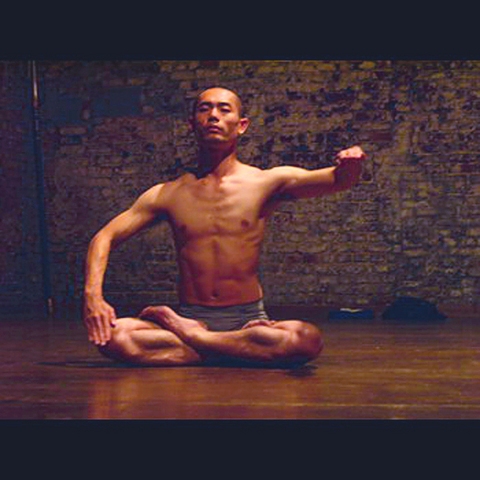
Next weekend's program — which begins with a Saturday matinee instead of a Friday night show — will shift the focus of the Novel series to the role of Asian men in contemporary dance, with performances by Pichet, Sang and Cheng.
Pichet, 35, will lead off the program with his half-hour long work I am a demon, which is a meditation on one of the four characters types — male, female, demon and monkey — in the traditional Thai masked dance theater known as Khon.
Pichet began training with one of the most famous masters of the demon form when he was 16, before going on to earn a bachelor's degree in Thai classical dance from Chulalongkorn University, Thailand's top school. In I am a demon, Pichet explains what makes a good demon dancer as he explores the structures and movements of the character.
Pichet appeared at Novel Hall last year with French choreographer Jerome Bel as the two men talked about — and demonstrated — their training, work and philosophy of dance. In that show, Pichet spoke about the frustration of trying to meld Khon with contemporary dance, a fusion that has been well received internationally but that has left many people in Thailand cold.
Following Pichet will be Gansu Province-born Sang, who will be performing Sheng You. A former dancer with China's Guangdong Modern Dance Company, the 33-year old Sang is also a former recipient of a Rolex Mentor and Protege Arts Iniative scholarship to study with William Forsythe at the Frankfurt Ballet.
Capping off the bill will be Cheng with Tete Bech, which won the bronze medal at the 1st International Choreography Competition Ludwigshafen 2006, beating out hundreds of competitors. Cheng, a 2002 graduate of the Taipei National University of the Arts, is the only Taiwanese to win a medal in this competition and that was obviously a key factor in his inclusion in the program. At 20, he is also the youngest performer in the series, but he already has eight works to his credit.
For the third weekend, Novel fans will be happy to welcome back Saburo Teshigawara, who will be performing his 55-minute Pages in Bones, which was created at the Theatre am Turm in Frankfurt in 1991. It really is almost a one-man show (two female dancers make a brief appearance). Not only is Teshigawara the choreographer and dancer, he designed the lighting, costumes and worked with Kei Miyata on the score.
Like Karttunen's Keiju, the Bones tells the story of a man's search for his position in space and time, and while Teshigawara is very different in looks and approach from the Finn, he is equally a magician of movement, frequently appearing to be suspended in air rather than dancing through it.
The Men Dancing series will wrap up in September with Akram Khan and Sidi Larbi Cherkaoui in Khan's Zero Point, something that people who met him or heard him speak when he was here earlier this year working with Cloud Gate on Lost Shadows are eagerly looking forward to.

Wooden houses wedged between concrete, crumbling brick facades with roofs gaping to the sky, and tiled art deco buildings down narrow alleyways: Taichung Central District’s (中區) aging architecture reveals both the allure and reality of the old downtown. From Indigenous settlement to capital under Qing Dynasty rule through to Japanese colonization, Taichung’s Central District holds a long and layered history. The bygone beauty of its streets once earned it the nickname “Little Kyoto.” Since the late eighties, however, the shifting of economic and government centers westward signaled a gradual decline in the area’s evolving fortunes. With the regeneration of the once

Even by the standards of Ukraine’s International Legion, which comprises volunteers from over 55 countries, Han has an unusual backstory. Born in Taichung, he grew up in Costa Rica — then one of Taiwan’s diplomatic allies — where a relative worked for the embassy. After attending an American international high school in San Jose, Costa Rica’s capital, Han — who prefers to use only his given name for OPSEC (operations security) reasons — moved to the US in his teens. He attended Penn State University before returning to Taiwan to work in the semiconductor industry in Kaohsiung, where he

In February of this year the Taipei Times reported on the visit of Lienchiang County Commissioner Wang Chung-ming (王忠銘) of the Chinese Nationalist Party (KMT) and a delegation to a lantern festival in Fuzhou’s Mawei District in Fujian Province. “Today, Mawei and Matsu jointly marked the lantern festival,” Wang was quoted as saying, adding that both sides “being of one people,” is a cause for joy. Wang was passing around a common claim of officials of the People’s Republic of China (PRC) and the PRC’s allies and supporters in Taiwan — KMT and the Taiwan People’s Party — and elsewhere: Taiwan and

On May 2, Chinese Nationalist Party (KMT) Chairman Eric Chu (朱立倫), at a meeting in support of Taipei city councilors at party headquarters, compared President William Lai (賴清德) to Hitler. Chu claimed that unlike any other democracy worldwide in history, no other leader was rooting out opposing parties like Lai and the Democratic Progressive Party (DPP). That his statements are wildly inaccurate was not the point. It was a rallying cry, not a history lesson. This was intentional to provoke the international diplomatic community into a response, which was promptly provided. Both the German and Israeli offices issued statements on Facebook